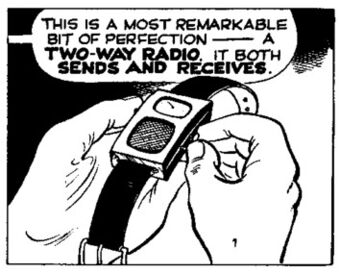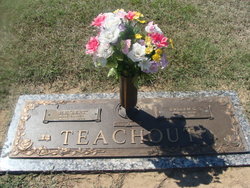“I have the most ill-regulated memory. It does those things which it ought not to do and leaves undone the things it ought to have done.”
Dorothy L. Sayers, Gaudy Night
Terry Teachout on the arts in New York City
“I have the most ill-regulated memory. It does those things which it ought not to do and leaves undone the things it ought to have done.”
Dorothy L. Sayers, Gaudy Night
“A happy childhood can’t be cured. Mine’ll hang around my neck like a rainbow, that’s all, instead of a noose.”
Hortense Calisher, Queenie

A new episode of Three on the Aisle, the twice-monthly podcast in which Peter Marks, Elisabeth Vincentelli, and I talk about theater in America, is now available on line for listening or downloading.
Here’s American Theatre’s “official” summary of the proceedings:
To listen to or download this episode, read more about it, or subscribe to Three on the Aisle, go here.Today the critics are doing a decade roundup, but not a “top 10” or “best of” list—we figure you’ve seen enough of those already! Instead they talk about some notable trends that have shaped the American theatre in the last 10 years, including the rise of Black playwrights and female directors, and the persistent lack of comedies onstage.
They close out, as always, with a discussion of recent plays. This week that list includes Greater Clements off Broadway, Sing Street at New York Theatre Workshop, and the launch of the national tour of My Fair Lady at the Kennedy Center.
In case you’ve missed any previous episodes, you’ll find them all here.
Imogene Coca and James Starbuck perform their comedy version of the pas de deux from Tchaikovsky’s The Sleeping Beauty on TV in 1951. This performance was originally telecast live as part of an episode of Your Show of Shows that aired on NBC on September 8, 1951:
(This is the latest in a series of arts- and history-related videos that appear in this space each Monday, Wednesday, and Friday)
“Not the power to remember, but its very opposite, the power to forget, is a necessary condition for our existence.”
Sholem Asch, The Nazarene

As I watched Dolemite Is My Name on Netflix the other day, I realized that I never anticipated living to see the end of movies as a public and collective viewing experience. Yet it’s well on the way to happening: Dolemite, like The Highwaymen and The Irishman, was made for and released on streaming video, as are a fast-growing proportion of non-franchise movies aimed at adult audiences. Indeed, a full year has gone by since I last saw a new feature film, They Shall Not Grow Old, in a theater.
This led me to ask: what other things did I fail to envision taking place in my lifetime? Among the biggest ones was the fall of the Berlin Wall, of which I now own a small piece embedded in Lucite. I use it as a paperweight, and every time I look at it, I’m reminded of the limits of human imagination.Here are a few others, some public and others deeply personal:
• The mainstreaming of “foreign food” in American culture. When I was growing up in Smalltown, U.S.A., you ordered steak, fish, or chicken in restaurants. The first time I ate Italian food (not counting pizza and spaghetti) in a restaurant, it struck me as unimaginably exotic. Today it’s a routine part of my diet, just as few months go by when I don’t have occasion to eat Chinese, Japanese, Thai, or Mexican food, to name only a handful of culinary possibilities. Yes, I live in New York City, but nowadays such cuisines are readily available from coast to coast.

• Smartphones. The cartoons and comic strips of my childhood were full of technological prophecies that have yet to come to pass—but not so Dick Tracy’s celebrated “two-way wrist radio,” which has long since been outstripped by reality. For better or worse? I increasingly think the latter, but it doesn’t matter: we are all plugged in now.
• My sixtieth birthday. I’d imagined turning fifty—pretty much everyone does, unless they have reason not to—but the arrival of my sixtieth birthday, by contrast, came as something of a surprise. When it finally rolled around, I celebrated by preparing to make my professional debut as a stage director, which is a good way to obscure the otherwise painfully obvious fact that you’ll never see fifty again.• The death of my parents. Even though I knew better deep down inside, I still thought they’d live forever, and when I finally lost them both, I knew my world would never be the same. Nor has it been. Not a day goes by that my brother and I don’t remember them with infinite tenderness.
Here’s something I wrote six years ago:
I wonder if either of them guessed how often I’d think about them after they were gone. Not surprisingly, I did so when my first play opened in New York, knowing that the occasion would have meant the world to them. But it’s the routine occasions, not the special ones, that mean the most to me. I think of my mother, for instance, whenever I take a cab down to the theater district to see a show, that being the time when I usually called her–as I did most days–to chat about whatever might be on our minds. I think of my father, by contrast, whenever I happen to see Perry Mason on TV, for he loved nothing more than to guess who did it midway through each episode, if not sooner. (He usually got it right, too.)
I still do.
From 2005:
Read the whole thing here.I went to my framer yesterday afternoon and picked up the presidential commission for my appointment to the National Council on the Arts. It is a splendidly old-fashioned document, about twice the size of a college diploma, printed in copperplate script on thick cream paper by the Bureau of Engraving and Printing. It is, of course, a fill-in-the-blank form, starting with a space on top for the current president’s name, with the blanks filled in by a calligrapher….
“Lately I have had the feeling that I have my whole life to consider and enjoy, especially the periods that were especially nice and that when I was younger I might have regretted because they didn’t go on longer. Now I think, Wasn’t that nice, Wasn’t I lucky.”
William Maxwell, letter to Eudora Welty, Dec. 19, 1993 (courtesy of Anecdotal Evidence)
One month ago this past Saturday, Mrs. T and I were sitting on the couch in our living room in upper Manhattan, watching Gone With the Wind on TCM, when she went into a full-scale respiratory crisis arising from pulmonary hypertension, the illness for which she is awaiting a double lung transplant. I called 911 at once, and an ambulance arrived a few minutes later and rushed her to the emergency room of New York-Presbyterian Hospital, her transplant center. Twenty-four hours after that, she was moved across the street to the hospital’s intensive-care unit. She’s been there ever since.
I’ve been posting fairly frequent updates about her condition on Twitter and Facebook, but it occurred to me over the weekend that it was time for me to write a more detailed report on how she’s doing now, and to make it more widely available by posting it in this space. Here it is.
* * *
It would be an understatement to say that things were touch-and-go during Mrs. T’s first two weeks in the ICU. We nearly lost her the first night, and in order to save her life, she had to be put on an ECMO machine, a heart-lung support system. Several more days went by before the doctors were able to stabilize her vital signs and take her off the machine. By then, the transplant team feared that she had grown too frail to survive surgery, which led to serious discussions about removing her from the transplant list and putting her in “comfort care,” a not-very-subtle euphemism for hospice care.That was when Mrs. T knew she had to start pushing back—hard.
The very next morning, she started making dramatic progress in her daily physical-therapy sessions. By the beginning of her third week in the ICU, it was clear to everyone that she was well on the way to building up enough stamina to stay on the transplant list, and she continues to grow measurably stronger with each passing day. Three weeks ago, she could only walk 15 feet on her bedside treadmill; on Saturday, she walked 460 feet. This is what marriage is all about: I have never been prouder of my gallant spouse, or loved her more.
We’re now concentrating on the equally daunting challenge of putting weight back on Mrs. T, who’s lost an alarming amount of it. This is easier said than done, for the meds that she takes have made her anorexic, on top of which she doesn’t much like hospital food (as who does?). Fortunately, she’s getting used to the limitations of the cuisine at New York-Presbyterian, which I augment with whatever she asks for. Above all, she understands that for now, she’s got to view eating as work, not pleasure.
In addition, her palliative-care doctors have persuaded her to be more sensible about taking full doses of her pain medication, which she had previously shunned out of fear of addiction but now realizes is essential so that she can continue to make progress in physical therapy. (It simply hadn’t occurred to her that physical pain is debilitating in and of itself!)

So far as we now know, Mrs. T will have to remain in the ICU until a pair of donor lungs finally becomes available and she is successfully transplanted and has recovered from the surgery. Until then, she will likely need high-flow supplemental oxygen around the clock, which is something she can’t get at home. She’s gradually growing accustomed to the prospect, though, and we’re a lot more optimistic today than we were a month ago, back when things were looking grimmer by the hour.
At the same time, it’s also true that we’re playing an increasingly urgent waiting game. To be sure, Mrs. T is at the very top of the transplant priority list, but she needs a pair of lungs from a donor of short stature with A-positive or O-type blood, and such folk don’t come along every day, or even every month. The truth is that we haven’t gotten a single donor offer since last August, when we received two Big Calls in a row, each of which fell through a few hours later. Since then, our cellphones have yet to ring. As for me, I came pretty close to burning out last month, but once it became clear that Mrs. T’s condition had become reasonably stable, she insisted that I get out of town for a couple of days and let the ICU nurses worry about her. I went to one of our favorite retreats by the Delaware River, where the staff took loving care of me. (We’ve been going there for fifteen years, and they know all about Mrs. T’s condition.) In addition, my editors at The Wall Street Journal ordered me to take two weeks off—no shows, no deadlines, no nothing—and I still have a week of down time left. Thanks to all this, I’m finally starting, very gradually, to feel like myself again.
Meanwhile, I visit Mrs. T in the ICU every day, bringing whatever food sounds good to her—she had a yen for cinnamon graham crackers the other day—as well as anything else she asks for. It helps that New York-Presbyterian is only a mile from our apartment, a reminder that we were smart to move to this neighborhood ten years ago in preparation for her eventual transplant. The TV in her room is hooked up to TCM, so we watch the eight o’clock movie together most nights. In recent days Teachout Theater has presented Harry and Tonto, The Phenix City Story, Ride the High Country, and Written on the Wind. Except for the part where she’s in a hospital bed hooked up to six IV lines, it’s kind of like being at home, sort of.
And that’s where we stand as of today. Yes, it’s been rough—terrifyingly so—but things aren’t nearly as bad as they were, and I’m starting to think that we might get through this, thanks in no small part to your support. Mrs. T isn’t quite ready for outside visitors yet, but we’re hoping that will come soon. In the meantime, your kind words and good wishes continue to buoy us up as we wait, watch the clock, and hope.
Glenn Gould plays his own transcription for solo piano of Maurice Ravel’s La Valse. This performance was originally telecast by the CBC in 1975:
(This is the latest in a series of arts- and history-related videos that appear in this space each Monday, Wednesday, and Friday)
| M | T | W | T | F | S | S |
|---|---|---|---|---|---|---|
| 1 | 2 | 3 | 4 | |||
| 5 | 6 | 7 | 8 | 9 | 10 | 11 |
| 12 | 13 | 14 | 15 | 16 | 17 | 18 |
| 19 | 20 | 21 | 22 | 23 | 24 | 25 |
| 26 | 27 | 28 | 29 | 30 | 31 | |
An ArtsJournal Blog